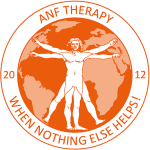Fibromyalgia is a chronic condition affecting about 2% of the population worldwide, with 90% of cases in women. The exact cause of this condition is unknown, but it is believed to be a combination of genetic, environmental, and physiological factors.
ANF Therapy®️ is the newest treatment for fibromyalgia based on the principle of frequency medicine. Unlike traditional methods, which often focus on symptom relief through medication, ANF Therapy®️ targets the root causes of pain and dysfunction. It aims to activate the body’s natural healing process by optimising the neurological frequencies.
What are four Stages of fibromyalgia?
People with fibromyalgia often experience pain, sleep disturbances, fatigue, and a variety of other symptoms. As the condition progresses, the symptoms become more intense. Though ANF Therapists assess fibromyalgia based on the severity of inflammation and symptoms, it can also be divided into four stages. Let’s have a look.
Fibromyalgia is typically divided into four progressive stages, although not every individual experiences each stage in the same order or intensity. The condition can fluctuate, with people moving between stages, experiencing remissions, or living with long periods of stability.
Here are 4 stages of fibromyalgia:
Stage 1 – Regional fibromyalgia with localised pain and classic symptoms
Initially, the symptoms of fibromyalgia are often localised to specific regions of the body. You might experience mild symptoms at this stage, which often go unnoticed. Those symptoms may mimic conditions like muscle strain or joint pain.
Here’s what you usually experience at this stage:
- Localised pain, often limited to neck, shoulders, or lower back.
- Mild to moderate fatigue that can affect daily activities.
- Difficulty sleeping or staying asleep, which leads to unrefreshing sleep.
This stage is an early warning sign for many, with symptoms often triggered by stress or trauma.
Stage 2 – Generalised fibromyalgia with increasing widespread pain
As fibromyalgia progresses, the pain becomes more widespread and affects multiple areas of the body. At this stage, you might experience:
- Pain spreads to other parts of the body, including arms, legs, and torso
- Increased fatigue makes daily tasks even more difficult.
- Problems with memory, focus, and concentration. Also, it leads to brain fog.
- Increased sensitivity to light, noise, odours, and temperature.
Stage 3 – Advanced fibromyalgia with chemical sensitivity and sleep disturbances
At this stage, fibromyalgia becomes more debilitating. Pain is constant, and other symptoms become more intense. This stage can severely affect the quality of life.
The key symptoms include:
- Severe pain in different parts of the body
- Chemical sensitivity, such as those found in perfumes, cleaning products, or medications.
- Severe sleep disturbances lead to extreme fatigue.
- Increased anxiety, depression, or irritability due to constant pain and fatigue.
Stage 4 – Secondary fibromyalgia reactive to other health conditions
At this stage, fibromyalgia becomes secondary to other chronic health conditions, such as rheumatoid arthritis, lupus, or irritable bowel syndrome. The coexisting conditions often make fibromyalgia symptoms more severe and more complex to manage.
Common symptoms include:
- Coexisting conditions like:
- Lupus
- Interstitial cystitis
- Rheumatoid arthritis
- Temporomandibular joint disorders
- Postural tachycardia syndrome
- Chronic fatigue syndrome
- Anxiety & depression
- Severe limitations due to which daily tasks become much more difficult, and you may need help with routine activities.
- Chronic pain that doesn’t improve easily with treatment.
Managing secondary fibromyalgia involves treating both the underlying condition and fibromyalgia symptoms. ANF Therapy®️ is the newest treatment for fibromyalgia.
ANF Therapy®️, The Newest Treatment For Fibromyalgia
ANF Therapy®️ may be the most effective treatment for fibromyalgia that focuses on restoring the body’s natural ability to heal itself. It utilises specially designed ANF Devices, which emit unique frequencies to support optimal neurological function and reduce inflammation. This non-invasive therapy aims to provide rapid and noticeable improvements, often from the very first session, making it a promising option for patients who have struggled to find effective solutions.
How does ANF Therapy®️ treat fibromyalgia?
ANF Therapy®️ aims to identify and correct imbalances in the body’s electrical and biochemical systems that contribute to the widespread pain and fatigue experienced by fibromyalgia patients. This therapy aims to modulate the nervous system’s response, help reset abnormal pain signals, and reduce hypersensitivity in fibromyalgia patients. It also promotes increased blood flow and lymphatic drainage, which aids in detoxification and reduces the buildup of inflammatory substances. This holistic method not only targets pain but also addresses the root of other symptoms, such as sleep disturbances and cognitive difficulties.
This treatment involves the following steps:
History
Your ANF Therapist will first take a detailed history. Comprehensive history-taking includes assessing the severity of pain, sleep disturbances, fatigue, and cognitive symptoms and reviewing previous treatments and other medical conditions.
Physical Examination
In physical examination, your ANF Therapist will focus on detecting muscle tenderness, trigger points, nerve sensitivity, posture, and range of motion to understand the extent of fibromyalgia’s impact.
Application of ANF Devices
After history and neurological examination, your ANF Therapist will apply certain devices to your body. These devices include positive and negative anti-inflammatory devices, antioxidant devices (glutathione and carnosine), energy devices, nitric oxide devices, and many others to support all systems of your body.
Expected Outcome
According to Dr Mikel H-G Hoff (founder of ANF Therapy®️), most patients experience significant pain reduction and symptom relief, often achieving around 50% improvement in the first session.
Follow-Up
Your ANF Therapists will conduct regular follow-ups to monitor progress, adjust treatment plans, and provide guidance on changing ANF Devices every 72 hours for optimal results. The treatment may take 2-6 months.
Start your journey with ANF Therapy®️:
ANF Therapy®️ is the newest treatment for managing fibromyalgia. If you have fibromyalgia, consult an ANF Practitioner or find an ANF Therapist to start your treatment with ANF Therapy®️ today!
If you’re a healthcare practitioner and want to enhance your clinical skills with frequency medicine, learn more about the ANF Therapy®️ and ANF Clinical education program by visiting www.anfacademy.com










